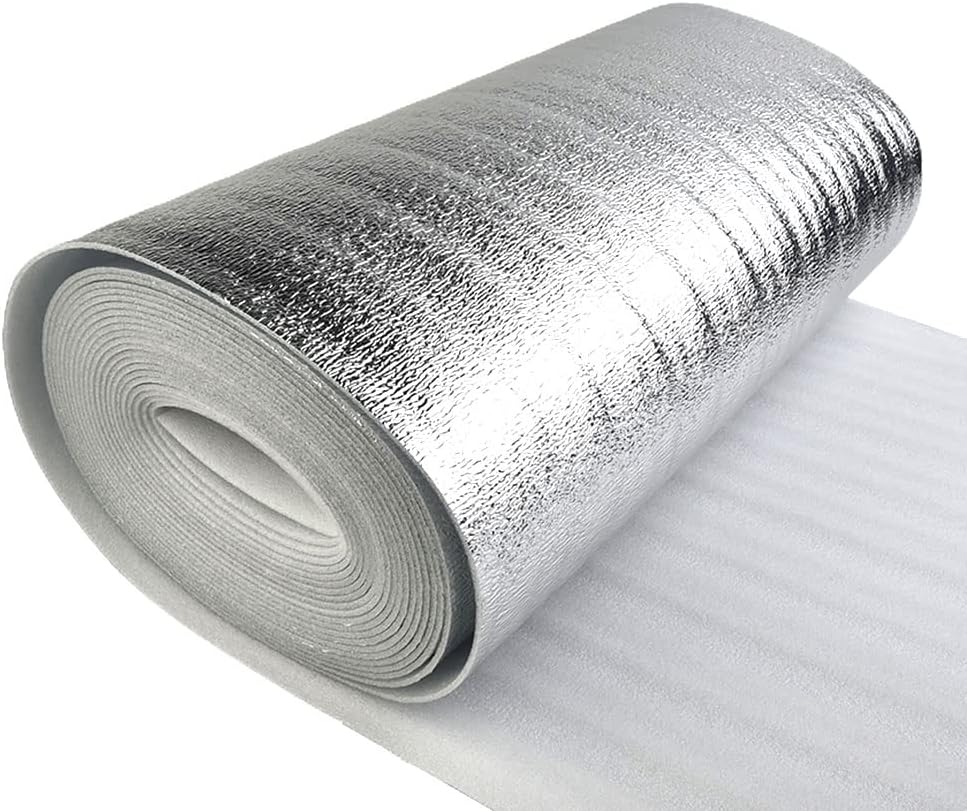Maximize Energy Savings with Aluminum Foil Heat Insulation Reflective Foil
Are you tired of watching your energy bills climb higher each season? You're not alone. Heating and cooling account for a significant portion of household energy consumption. Finding effective ways to improve your home's thermal performance is crucial for both your wallet and the environment. While traditional insulation plays a role, there's another powerful tool in the energy-saving arsenal: aluminum foil heat insulation reflective foil.
Often referred to as a radiant barrier, this unassuming material packs a serious punch when it comes to reducing unwanted heat transfer. Unlike bulk insulation (like fiberglass or cellulose) which slows down conductive and convective heat flow, reflective foil tackles radiant heat – the invisible energy waves that travel through space. This article will guide you through how aluminum foil heat insulation reflective foil works, where to use it for maximum impact, and how it can significantly contribute to lowering your energy consumption and maximizing your savings. Get ready to reflect heat and retain comfort!

Understanding How Aluminum Foil Heat Insulation Reflective Foil Works
To appreciate how this foil saves energy, it's helpful to understand the basics of heat transfer and the unique properties of reflective materials.
The Science Behind Reflectivity and Heat Transfer
Heat moves in three ways:
- Conduction: Heat transfer through direct contact (e.g., a hot pan handle).
- Convection: Heat transfer through the movement of fluids (liquids or gases, like warm air rising).
- Radiation: Heat transfer via electromagnetic waves (like the sun warming your face or heat radiating from a hot roof).
Traditional insulation primarily slows down conduction and convection. However, aluminum foil heat insulation reflective foil is specifically designed to combat radiant heat transfer. In summer, a significant amount of heat gain in homes comes from solar radiation heating up the roof. In winter, indoor heat radiates outwards towards colder surfaces.
Highly reflective materials, like aluminum foil, have a low emissivity. Emissivity is the measure of a surface's ability to emit (release) radiant energy. Standard building materials typically have high emissivity (around 0.9), meaning they readily radiate heat. Aluminum foil, however, can have an emissivity as low as 0.03-0.05. This means it reflects about 95-97% of radiant heat hitting its surface and emits very little heat itself. As the U.S. Department of Energy notes, radiant barriers are particularly effective in hot climates by reducing summer heat gain.
Key Features that Boost Energy Efficiency
Several characteristics make aluminum foil heat insulation reflective foil an energy-saving champion:
- High Reflectivity/Low Emissivity: Its primary function – blocking the vast majority of radiant heat transfer.
- Requires Air Space: For optimal performance, the reflective foil needs to face an air gap (at least 3/4 inch). Without this gap, it becomes conductive and loses its reflective advantage.
- Lightweight & Thin: Easy to handle and install without adding significant weight or bulk to structures.
- Non-Toxic: Generally safe to handle and install.
- Vapor Barrier (Optional): Some versions include perforations to allow moisture vapor to pass through, while others act as a vapor barrier, which can be beneficial or detrimental depending on the climate and application.
Key Applications for Maximum Energy Savings
To truly maximize energy savings, install aluminum foil heat insulation reflective foil where radiant heat transfer is most significant.
Attics: Your First Line of Defense
Your attic is often the hottest part of your house in summer and a major source of heat loss in winter. Installing reflective foil here can make a substantial difference.
- Summer: Stapled underneath the roof rafters (with the reflective side facing down towards the air gap/attic floor), it blocks solar heat radiating from the hot roof decking, preventing it from heating the attic space and the rooms below. This significantly reduces the load on your air conditioning system.
- Winter: While less impactful for heat loss than gain, it can help reflect some rising heat back down towards the living space if installed correctly, complementing existing insulation.
- Installation: It can be laid over existing attic floor insulation (reflective side up, facing the attic air space), but care must be taken not to compress the existing insulation. Installation under rafters is generally preferred for summer heat gain reduction.
Walls and Crawl Spaces
While attics are the prime location, reflective foil offers benefits elsewhere:
- Walls: In hot climates, incorporating aluminum foil heat insulation reflective foil into wall systems (facing an air gap) can reduce radiant heat gain through sun-baked walls.
- Crawl Spaces: Installing reflective foil under the floor joists (reflective side facing down) in vented crawl spaces can reduce heat loss in winter and potentially help manage moisture.
Beyond the Home: Sheds, Garages, and More
Don't limit your thinking to just the main house!
- Garages & Workshops: These spaces often lack traditional insulation and can become ovens in the summer. Reflective foil under the roof can make them significantly more comfortable.
- Sheds & Agricultural Buildings: Keep stored items or livestock cooler by reducing radiant heat gain.
Installation Best Practices for Optimal Performance
Proper installation is paramount to achieving the energy savings promised by aluminum foil heat insulation reflective foil. Cutting corners here will drastically reduce its effectiveness.
The Importance of Air Gaps
This cannot be stressed enough: Reflective foil MUST face an air gap to work. The reflective properties function by reducing radiant heat transfer across a space. If the foil is in direct contact with another material (like roof decking or drywall), it will simply conduct heat instead of reflecting it. Aim for an air gap of at least 3/4 inch (19mm), though larger gaps are also effective.
Sealing Joints and Edges
Ensure a continuous reflective barrier. Overlap seams by a few inches and seal them securely using a manufacturer-recommended foil tape. Seal around edges and any penetrations (wires, pipes) to prevent air leakage, which can undermine insulation performance.
Safety First: DIY vs. Professional Installation
While installing reflective foil can be a DIY project, safety is crucial:
- Attic Hazards: Attics can be extremely hot, contain dust and irritants, and may have hidden electrical wiring or unstable footing. Wear appropriate protective gear (gloves, mask, eye protection). Be cautious around electrical boxes and wiring.
- Stapling: Use appropriate staples (often T50 staples) and be careful when working overhead.
- When to Call a Pro: If you're uncomfortable working in confined, hot spaces, unsure about electrical safety, or want guaranteed proper installation, hiring a qualified insulation contractor is a wise investment.
Quantifying the Savings: What to Expect
The exact energy savings will vary, but aluminum foil heat insulation reflective foil offers a tangible return on investment.
Factors Influencing Energy Reduction
Several factors determine how much you'll save:
- Climate: Savings are generally highest in hot, sunny climates where reducing solar heat gain is critical. According to the Reflective Insulation Manufacturers Association International (RIMA-I), radiant barriers are most effective in cooling-dominated climates.
- Installation Quality: Correct placement and ensuring air gaps are essential.
- Location: Attic installations typically yield the most significant savings.
- Existing Insulation: Reflective foil complements, rather than replaces, existing bulk insulation. Its impact might be perceived as greater in homes with poor existing insulation.
Potential ROI and Long-Term Value
Studies and field tests have shown that properly installed radiant barriers in attics can reduce cooling costs by 5% to 10% or even more in very hot climates. While this percentage might seem modest, it adds up significantly over the lifespan of the foil, which is typically very long as it doesn't degrade easily. Considering the relatively low material cost and potential for DIY installation, aluminum foil heat insulation reflective foil often provides a quicker return on investment compared to more extensive energy upgrades. It's a cost-effective way to boost your home's thermal defense against radiant heat.
Conclusion: Reflect Your Way to Lower Energy Bills
Maximizing energy savings is about employing smart strategies. Aluminum foil heat insulation reflective foil offers a scientifically sound and cost-effective method to combat radiant heat transfer – a major factor in home energy consumption, especially during cooling seasons. By understanding how it works, applying it in the most impactful locations like attics, and ensuring correct installation with necessary air gaps, you can significantly reduce heat gain in summer and retain some heat in winter. It’s a versatile material that complements traditional insulation, helping you create a more comfortable living environment while noticeably trimming down those energy bills.
Take the Next Step
Ready to put reflective foil to work for you?
- Assess Your Home: Check your attic – is there potential to add a radiant barrier?
- Learn More: Research specific aluminum foil heat insulation reflective foil products suitable for your climate and application.
- Share Your Thoughts: Have you used reflective foil? Share your experience or questions in the comments below!
- Stay Informed: Subscribe to our newsletter for more practical energy-saving tips and home improvement guides!

